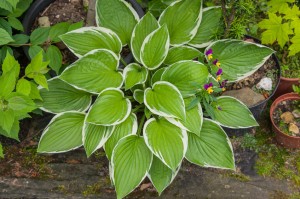 Hostas give that lush jungle feel to your garden. Different varieties mix shades of the darkest blackish greens with the lightest yellow-greens. They fill up flat corners with mounds of large spectacular leaves. Because most are generally shaped in those circular fountains of long-veined leaves, some people have a difficult time noticing that there are so many different species. Using labels for hostas will help you arrange your hostas in beautiful patterns, introduce them to friends and find them in the early spring as they emerge from the bare ground.
Hostas give that lush jungle feel to your garden. Different varieties mix shades of the darkest blackish greens with the lightest yellow-greens. They fill up flat corners with mounds of large spectacular leaves. Because most are generally shaped in those circular fountains of long-veined leaves, some people have a difficult time noticing that there are so many different species. Using labels for hostas will help you arrange your hostas in beautiful patterns, introduce them to friends and find them in the early spring as they emerge from the bare ground.
Grouping hostas together is an art. Small hostas look nicely grouped together so they are not overwhelmed by a large variety. When you arrange large and small hostas together, it’s nice to accent them around large rocks or other sculptural garden art pieces. Hostas soften edges with their cascading leaves. Use them to cover the 90-degree corners of porch or patio steps, tuck them between tall late summer bloomers to hide the flowers’ bare “legs” or use a large lush hosta as the anchor plant to welcome people into your garden.
In the fall, after the growing season, many people cut away old frost-bitten hosta leaves to the ground. With no woody material left behind, hostas don’t have their own natural marker of where they’ll appear in the spring. Hostas might be hard to see as they start appearing in late spring because none of the plant material can be seen above ground.
In tightly spiraled leaves, hostas start to poke out of the soil in tiny bumps. A completely new plant arises from underground. If people or pets trample on these hard little leaf bumps they easily break off and the hosta will either be late in getting out of the ground or won’t be as healthy and full. Labels for hostas can help you remember just where all those hostas will appear in the spring and will help family and friends step around them rather than step on them unknowingly. The labels for hostas will also help you know which species is an earlier bloomer than the rest and will allow you to know where to watch for the first hostas of spring.
Winter is a time for planning and re-thinking your garden, but with no markers of what species of hosta is where, it might be difficult to remember which was which. On warm winter days you can head out to the garden, note where certain hostas are currently sleeping by their plant markers and plan where you might want to divide or move some in the coming spring.
At Kincaid Plant Markers, we can create resilient long-lasting labels for your hostas so that all year round you can plan on new garden designs and in the spring you can keep your tender hostas leaves safe from harm.



![DSC04692[1]](https://www.kincaidplantmarkers.com/wp-content/uploads/2014/03/DSC046921-300x225.jpg)


